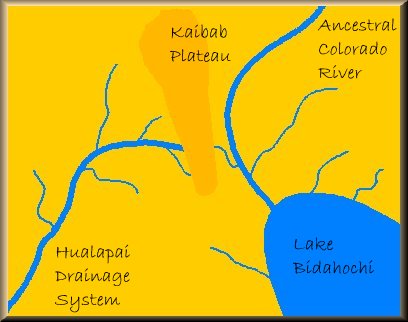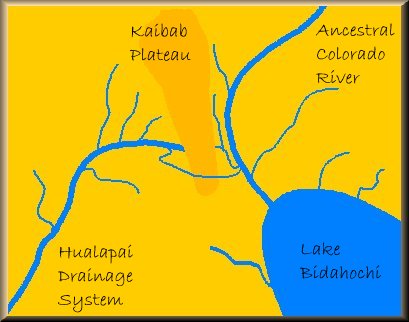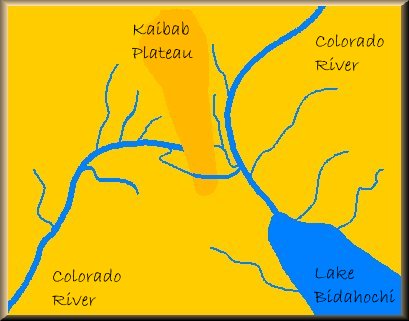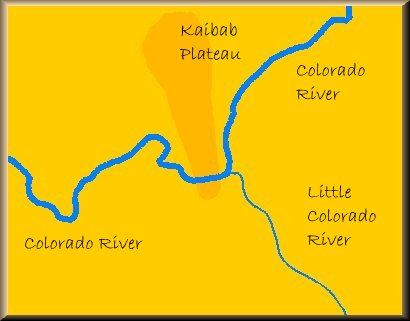 Prior to about 35 million years ago the ancestral Colorado River flowed across a vast plain, along a course very similar to that of today.
Prior to about 35 million years ago the ancestral Colorado River flowed across a vast plain, along a course very similar to that of today.
 When the Kaibab Plateau began to uplift approximately 35 million years ago the river was diverted to the southeast because it could not cross newly created barrier. The new course for the river now flowed out to the Gulf of Mexico instead of to the Pacific Ocean. The old course on west side of the Kaibab Plateau, the Hualapai Drainage System, continued to be a major drainage for the plateau itself and the regions west of it.
When the Kaibab Plateau began to uplift approximately 35 million years ago the river was diverted to the southeast because it could not cross newly created barrier. The new course for the river now flowed out to the Gulf of Mexico instead of to the Pacific Ocean. The old course on west side of the Kaibab Plateau, the Hualapai Drainage System, continued to be a major drainage for the plateau itself and the regions west of it.
 At some point around 12 million years ago, the river's course to the Gulf of Mexico became blocked and an enormous lake, know referred to as Lake Bidahochi, was formed as a result.
At some point around 12 million years ago, the river's course to the Gulf of Mexico became blocked and an enormous lake, know referred to as Lake Bidahochi, was formed as a result.
 Meanwhile, on the western side of the Kaibab Plateau, a process known as "headwater erosion" began eating its way through the southern portion of the plateau. After millions of years this erosional process allowed the Hualapai system to break through the barrier created by the uplifted plateau and rejoin the ancestral Colorado.
Meanwhile, on the western side of the Kaibab Plateau, a process known as "headwater erosion" began eating its way through the southern portion of the plateau. After millions of years this erosional process allowed the Hualapai system to break through the barrier created by the uplifted plateau and rejoin the ancestral Colorado.
 Once the break-through was complete the ancestral Colorado River began to follow the new course becuase of its steeper and more desirable descent. The waters of Lake Bidahochi began to drain through the new course as well and the result is the gorge through which the Little Colorado River now flows. The combined flow of the Colorado River and the Little Colorado River west of their confluence continued to widen and deepen the course and created the Grand Canyon.
Once the break-through was complete the ancestral Colorado River began to follow the new course becuase of its steeper and more desirable descent. The waters of Lake Bidahochi began to drain through the new course as well and the result is the gorge through which the Little Colorado River now flows. The combined flow of the Colorado River and the Little Colorado River west of their confluence continued to widen and deepen the course and created the Grand Canyon.
 After Lake Bidahochi was drained the space that it once occupied was replaced by the Little Colorado River drainage system.
After Lake Bidahochi was drained the space that it once occupied was replaced by the Little Colorado River drainage system.
 Prior to about 35 million years ago the ancestral Colorado River flowed across a vast plain, along a course very similar to that of today.
Prior to about 35 million years ago the ancestral Colorado River flowed across a vast plain, along a course very similar to that of today.